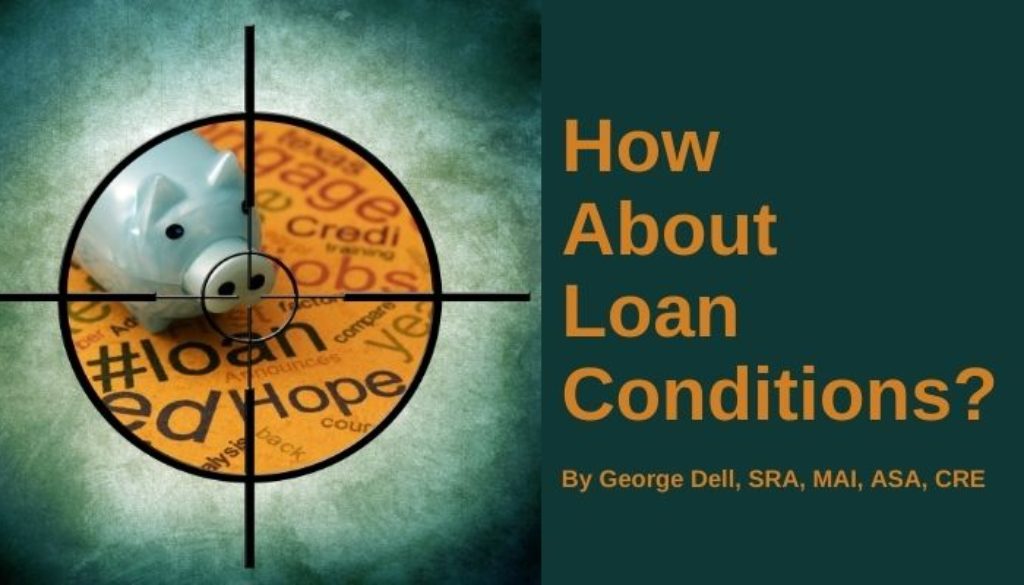How about “loan conditions”? Clients only need a value in order to quantify risk. Is this scary?
Editor’s Note: This post is an intersection of Modernization and Risk.
There are only three uses for knowing value: 1) collateral loss, 2) investment gain, 3) equitability.
Historical value may only be relevant to #3. Loss or gain of value only relate to future expectations. Investors and lenders should care about micro-forecast as well as macro-conditions.
Lenders need to estimate future value. Will it be enough to cover a ‘credit’ loss, (like a foreclosure)? Lenders need to consider two basic types of loss: 1) Individual borrower default and 2) Macro-economic conditions that cause a sea of defaults. Individual defaults are more or less an ongoing thing, and relatively easy to estimate loss into the risk/profit trade-off.
Macro-events risks are more difficult to estimate. Yet they seem to occur every 10-15 years. We seem always bewildered. How could this happen? What are we missing? Are we just blind? Are our systems, even our regulatory systems — biased to avoidance/ignorance of this recurring loss and societal damage?
It is worth a look. Risk. We have micro-risk, macro-risk, and “midi-risk.”
On the micro side, we have appraisals and AVMs. And we have alternate alternatives – all of which chip away at the requirements of being credible and reliable. In practice this amounts to less information on the subject, the comparables, and trends. Appraisal value disregards trend. Appraisal value is:
- “Most probable price” and
- Historical (albeit very recent).
Appraisers are restricted (by USPAP Advisory Opinion 34) from the use of data subsequent to the effective date, except only if it “would be reasonably be considered by a buyer or seller.” Effectively, (superior) appraiser knowledge of imminent conditions is prohibited from being communicated through to the lender collateral decision.
AVMs are not so restricted. In fact, there are no regulatory requirements on credibility or reliability. However, AVM companies are not judged by losses. They are judged only by their own ‘confidence’ rating, or by third-party raters.
Hybrids (or waivered) valuations are even more convoluted here, of both extremes. If the subject/comparable/proximate data gathering part is by a non-appraiser – then there are no limitations. However, whatever part a licensed appraiser does, is restricted by legacy appraisal practice, as well as the specific  instructions of USPAP AO-34.
instructions of USPAP AO-34.
So let’s look at the dichotomy. Micro-level providers are ineffective, unmotivated, or prohibited from any relevant forecast functionality.
Lenders, government agencies (like Farm Credit, FHA, and VA), and government-sponsored “Enterprises” (FannieMae and FreddieMac) have vast resources about macro-economic conditions.
So, what is missing? What’s missing is local, neighborhood, proximate, and adjacent influences. Midi-economic forecast indicators.
The greatest losses to agencies, lenders, and ultimately consumers and the public – are from ignored or avoided macro and midi influences.
We have the information. We know the risk algorithms. But individual players in the loan selling world are each motivated to ignore or minimize a risk that is not personal. Losses are later. Profit is now. Salary bonus today. Retirement soon. Market share is the goal. These factors affect loan conditions.
Loan conditions are like “sale conditions” or “market conditions.” How loose? What interest rate? What collateral ratio? What verifications? What points? Loan conditions may be the one single most important indicator of systemic losses in the world of real estate collateral loans. Loan conditions can be the difference between market price and true fundamental value.

The American Dream and Bias in Loans? - George Dell, SRA, MAI, ASA, CRE
February 8, 2023 @ 10:39 am
[…] Do we need a “loan conditions” adjustment? Read Part 2 here. […]